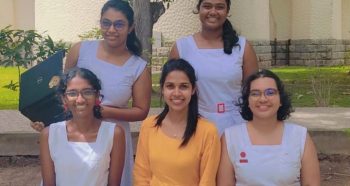With the growing sophistication of AI robots and the programs that control them, a report by McKinsey and Company in 2017 estimated that the current jobs of 800 million global workers could disappear by 2030. However, a Dell Technologies report of the same year asserted that 85 per cent of the jobs that will exist in 2030 hadn’t yet been invented.
What these statistics tell us is that Industry 4.0 is transforming how we work. Having a strong set of transferable and adaptable skills will provide learners with the best opportunities in a working environment that is being increasingly automatised.
Alongside these skills, learners need to develop the creative thought processes that will enable them to problem solve and innovate as part of their daily working lives, as well as to follow recognised processes or protocols.
Developing skills and mindset early
A worker will be better equipped to solve problems and think creatively if they have been doing so all their lives, which is why the Cambridge Primary and Lower Secondary Computing curriculum has been developed to support young learners in this way of working and thinking.
Cambridge Primary and Lower Secondary Computing has been designed with Industry 4.0 in mind. It supports learners to recognise the role of computer science in a range of industries, to develop computer science skills of their own and to recognise the role that computer science will play in their future careers.
Regardless of whether learners become computer scientists or move into a more traditional industry such as manufacturing, farming or the arts, we want them to realise the likelihood is that they will be working as part of a technology-driven industry as a result of Industry 4.0.
The World Economic Forum recognised, as far back as 2016, that even those who will work in traditional industries such as medicine, engineering, design and architecture will need to combine the new industrial tools of computational design, additive manufacturing, materials engineering, and synthetic biology within their work.
A Computing curriculum with solid foundations
The Cambridge Primary and Lower Secondary Computing curriculum has specific content strands and learning objectives that help young learners to understand each aspect of Industry 4.0 in as simple terms as possible and to develop skills that are central to all aspects of modern technology. The five strands are: Computational Thinking; Programming; Managing Data; Networks and Digital Communication; and Computer Systems.
The Computational Thinking strand includes analytical and critical thinking around digital concepts to find creative solutions to given problems. Learners will be able to apply this to other areas of the curriculum, in later education and in the workplace. We hope that this will lead to lifelong learning, develop an informed curiosity and a lasting passion for learning.
The Programming (coding) and Computer Systems strands help young learners to understand how devices work and how they respond to precise instruction and input.
By learning computational thinking and programming skills from an early age, learners will also be able to develop competencies such as logic and decomposition progressively, and before they have to contend with applying these within a professional and complex programming environment.
Young learners will have an opportunity to have fun with the programs that they create and will develop important knowledge and skills that can then be applied to contexts that increase in complexity throughout their education and beyond.
The Managing Data strand of the curriculum focuses on data modelling and analysis and how this is informing emerging technologies such as AI.
Learners should also understand that Industry 4.0 is underpinned by the connectivity between devices and will develop a growing understanding of how this connectivity is set up, including the Internet of Things. They will be able to learn about this through the Networks and Digital Communication strand.
Making ethical technology decisions
It is equally important that learners are able to make ethical decisions about the use of new technologies. Learners are equipped to make these decisions throughout the Computing curriculum, starting with understanding where robots are present in the real world, through to considering the benefits and risks of Industry 4.0.
Skills and knowledge developed through the Computing curriculum are complemented by those developed in other Cambridge Primary and Lower Secondary subjects – for example, Digital Literacy includes the impact of emerging technologies on individuals and supports learners to evaluate the positive and negative aspects of digital disruption on our everyday lives.
The development of Cambridge Global Perspectives skills (analysis, collaboration, communication, evaluation, reflection and research) also prepares learners to be contributors to the workplaces of the future, as will studying the global topics that they encounter.
There are also other opportunities for learners to develop creative thinking and problem-solving skills in Cambridge STEM subjects and in Art & Design and Music.
Computing without computers
While schools will need some computers and some internet access to deliver the course, many of the activities can be done away from the computer. Learners will actually benefit from applying computational thinking to other contexts such as physical movement activities. Their learning will also be enhanced when sharing computers, and ideas, when programming. Also, once tools, such as the free programming language Scratch, have been downloaded, much of the onscreen work can be done offline.
Additional tools that will help will be a small supply of programmable devices, such as Micro:bits, which can be obtained relatively cheaply and, with planning, shared across the whole school.
Because our Computing curriculum is as much about creating a way of thinking as it is about the technicalities of programming, there are many benefits that will support learners’ understanding if they can work away from the computer on ‘unplugged’ activities. They will also gain understanding from seeing examples of automation in local industries and from hearing descriptions from adults who work in these industries.
Preparing every student for the world of work
The content of the Cambridge Primary and Lower Secondary Computing curriculum has been designed to align to the Cambridge IGCSEs in Computer Science and ICT and to contextualise the role of computers for everybody, including those who are not likely to follow a computer science path in the future.
Essentially, we want learners to understand that, although they may not grow up to become computer scientists, there is an increasing likelihood that they will work alongside computer professionals during their adult lives – and the earlier they start to prepare for this future, the better equipped they will be.
More information
Cambridge Primary and Lower Secondary offers a choice of ten subjects, and a range of optional assessments, for learners typically aged 5 to 14 years.
Find out more about Cambridge Primary Computing
Find out more about Cambridge Lower Secondary Computing





